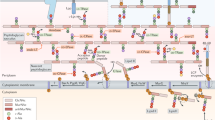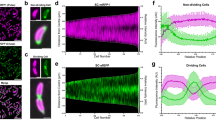Abstract
THE Myxobacteriaceae are unique among prokaryotes in their development cycle. Vegetative cells are Gram-negative bacilli which undergo binary fission as in other prokaryotes; alternatively, the cells can aggregate on solid surfaces to form fruiting bodies in which the bacteria undergo conversion to myxospores. In Myxococcus xanthus and related species a simple fruiting body is formed in which spherical myxospores are surrounded by extracellular polysaccharide slime1. In at least one strain of M. xanthus, synchronous myxospore formation can be obtained in liquid culture through induction with glycerol and other agents2. The entire bacillus undergoes conversion to the myxospore form; there is no apparent loss of cell material such as is observed in the morphogenesis of Gram-positive bacilli to endospores at the expense of cell wall and surface material shed on emergence of the mature spore. The fate of the Myxococcus surface polymers is thus of particular interest.
This is a preview of subscription content, access via your institution
Access options
Subscribe to this journal
Receive 51 print issues and online access
$199.00 per year
only $3.90 per issue
Buy this article
- Purchase on Springer Link
- Instant access to full article PDF
Prices may be subject to local taxes which are calculated during checkout
Similar content being viewed by others
References
Dworkin, M., Crit. Rev. Microbiol., 1, 435–452 (1972).
Dworkin, M., and Gibson, S. M., Science, 146, 243–244 (1964).
Voelz, H., and Dworkin, M., J. Bact., 84, 943–952 (1962).
Bacon, K., and Eiserling, F. G., J. Ultrastruct. Res., 21, 378–382 (1968).
White, D., Dworkin, M., and Tipper, D. J., J. Bact., 95, 2186–2197 (1968).
Sutherland, I. W., and Smith, M. L., J. gen. Microbiol., 74, 259–266 (1973).
Sutherland, I. W., and Thomson, S., J. gen. Microbiol., 89, 124–132 (1975).
Galanos, C., Lüderitz, O., and Westphal, O., Eur. J. Biochem., 9, 245–249 (1969).
Reichenbach, H., and Dworkin, M., J. Bact., 101, 325–326 (1970).
Johnson, R. Y., and White, D., J. Bact., 112, 849–855 (1972).
Freeman, G. G., Biochem. J., 36, 340–355 (1942).
Chin, T., Younger, J., and Glazer, L., J. Bact., 95, 2044–2050 (1968).
Author information
Authors and Affiliations
Rights and permissions
About this article
Cite this article
SUTHERLAND, I. Novel surface polymer changes in development of Myxococcus spp.. Nature 259, 46–47 (1976). https://doi.org/10.1038/259046a0
Received:
Accepted:
Issue Date:
DOI: https://doi.org/10.1038/259046a0
This article is cited by
-
Endotoxin-like activities inMyxococcus xanthus
Current Microbiology (1987)
Comments
By submitting a comment you agree to abide by our Terms and Community Guidelines. If you find something abusive or that does not comply with our terms or guidelines please flag it as inappropriate.



